ENG As the spirit of a self-contained creator, artist Stefan Fus, I have an obligation to remember what was and what is, so that what remains would be understandable to others.
PL Jako duch samoistnego twórcy, artysty Stefana Fusa, mam zobowiązanie do przypomnienia sobie tego: co było i co jest, aby to co pozostało było zrozumiałe dla innych.
| It is essential for the artist's work to develop his own style and technique, which Stefan Fus undoubtedly created and used over the years. |
“Man, through his actions, products of work, creativity and imagination, creates culture, thus shaping the image of himself and his own environment. Culture is a multifaceted, complex and varied phenomenon. Passed on to each generation through tradition, it is not repeated, but is significantly influenced by its identity."
K. Kwaśniewicz
Istotnym dla twórczości artysty jest wypracowanie własnego stylu i techniki, a te niewątpliwie Stefan Fus stworzył i w ciągu wielu lat stosował
„Człowiek poprzez swoje działanie, wytwory pracy, twórczość oraz wyobraźnię tworzy kulturę, kształtując w ten sposób obraz samego siebie i własnego otoczenia. Kultura jest zjawiskiem wieloaspektowym, złożonym, zróżnicowanym. Przekazywana każdemu pokoleniu poprzez tradycję, nie jest jednak powtarzana, ale pozostaje pod znaczącym wpływem swej tożsamości.”
K. Kwaśniewicz
| Following on this platform HIVE - sometimes - very personal entries, allowing me to get to know even the mutual relations in the families of the authors, including people I know personally, I decided to "enter the game" in HIVE.Most of the authors present everyday activities or plans for years of life, while I - due to my age - already think how to close the door behind me, i.e. how to finish at least some of my ideas / projects. |
Postać Stefana Fusa w publikacjach, w świetle jego twórczości, przybliżają: Prospekt wystawy ”Stefan Fus, Plastyka i malarstwo” w Sokołowie Młp., 1994, a także m.in.: Leszek Walicki [3], Krzysztof Ruszel [5, 6] (były dyrektor Muzeum Etnograficznego w Rzeszowie), Magdalena Kątnik-Kowalska [7, 8].
Śledząc na tej platformie HIVE – niekiedy – bardzo osobiste wpisy, pozwalające na poznanie nawet wzajemnych stosunków w rodzinach autorów, w tym osób znanych mi osobiście, postanowiłem „wejść do gry” w HIVE.
Większość autorów prezentuje czynności codzienne lub plany na lata życia, natomiast ja – ze względu na wiek – myślę już jak zamknąć drzwi za sobą, tzn. jak zakończyć przynajmniej niektóre z moich pomysłów/projektów.
| "In life, what counts are the years that a person has before him, and not those that have passed, although the years ahead cannot be calculated, and those can be." Stefan Fus [1] |
"W życiu liczą się te lata, jakie człowiek ma przed sobą, a nie te które minęły, chociaż tych lat przed sobą nie można obliczyć, a tamte można." Stefan Fus [1]
| Due to the fact that it is widely scattered around the world - from Sydney through London to Vancouver - scattered with the fate of war after WWII. family of Stefan Fus, the text will also be in English. Additionally, a family tree should be attached so that interested parties can place themselves in relation to S.F. | ||
| I think that the story of an unusual artist will also interest foreign readers. |
Ze względu na szeroko po świecie - od Sydney przez Londyn po Vancouver - rozrzuconą losami wojennymi po II w.ś. rodzinę Stefana Fusa, tekst będzie również w języku angielskim. Dodatkowo powinno być dołączone drzewo genealogiczne, aby zainteresowani ulokowali się względem S.F.
Myślę, że historia nietypowego artysty zainteresuje także zagranicznych czytelników.
| I want to put here records, documents and photos, which I will gradually acquire and collect. They are intended to be used as materials for the creation and publication of a monograph depicting the life and most of the works - some of the works have been lost - of the works of Stefan Fus (S.F.) in print, as internet domains and websites change owners, the content disappears, e.g. http://www.muzeumsztukiludowej.otrebusy.pl/index.php?page=fus-stefan (- only a copy is available) sometimes they are randomly copied to internet archives, and paper printouts are kept in library or private collections. I hope this blockchain will be an equally good and durable repository. I intend to obtain these materials from literature, from the artist's family and from several museums. | ||
| I expect that in the collection of several dozen old film films I will find photographs of products that have not survived in material form. |
Chcę tutaj umieszczać zapisy, dokumenty i fotografie, które będę stopniowo pozyskiwał i gromadził. W zamiarze mają posłużyć jako materiały do stworzenia i wydania drukiem monografii ukazującej życie i większość - część prac zaginęła - twórczości Stefana Fusa (S.F.) drukiem, gdyż domeny internetowe i strony www zmieniają właścicieli, treści znikają, np.
http://www.muzeumsztukiludowej.otrebusy.pl/index.php?page=fus-stefan (- dostępna jest tylko kopia), czasem losowo są kopiowane do archiwów internetowych, a wydruki papierowe trwają w zbiorach bibliotecznych lub prywatnych. Mam nadzieję, że ten blockchain będzie równie dobrą i trwałą składnicą.
Materiały te zamierzam pozyskać z literatury, od rodziny artysty i z kilku muzeów.
Spodziewam się, że w zbiorze kilkudziesięciu starych błon filmowych znajdę fotografie wytworów, które nie zachowały się w postaci materialnej.

| I hope that for the 120th birthday of Stefan Fus I will deal with the release of this album. |
Liczę, że na 120 rocznicę urodzin Stefana Fusa uporam się z wydaniem tego albumu.

| On the Internet, I unexpectedly came across articles and materials documenting life (M. Kątnik-Kowalska "Stefan Fus", Fakty i Realia, Gazeta Żołyńska No. 10, 2009, pp. 9-10; [https://www.pbc.rzeszow.pl/dlibra/publication/15071/edition/14068 ? language = en], Magdalena Kątnik-Kowalska, "Famous and less known Żołyń culture creators, Stefan Fus", Facts and Realia, Gazeta Żołyńska No. 2 pp. 18-19, Żołynia 2017 [https: //api.gok.zolynia .pl / storage / files / 882 / Fakty-i-Realia, -nr-2- (2020) -february-2017.pdf]. |
W internecie natrafiłem niespodziewanie na artykuły i materiały dokumentujące życie
(M. Kątnik-Kowalska „Stefan Fus”, Fakty i Realia, Gazeta żołyńska Nr 10, 2009, str. 9-10; [https://www.pbc.rzeszow.pl/dlibra/publication/15071/edition/14068?language=en], Magdalena Kątnik-Kowalska, „Znani i mniej znani żołyńscy twórcy kultury, Stefan Fus”, Fakty i Realia, Gazeta żołyńska Nr 2 str. 18-19, Żołynia 2017 [https://api.gok.zolynia.pl/storage/files/882/Fakty-i-Realia,-nr-2-(2020)-luty-2017.pdf].
| Stefan Fus was born on January 8, 1904 in Żołynia, and died on August 24, 1987 in Sokołów Małopolski. |
Stefan Fus urodził się 8.01.1904 r w Żołyni,
a zmarł 24.08.1987 r. w Sokołowie Małopolskim.
Location of Żołynia on the map of Poland ----- Umiejscowienie Żołyni na mapie Polski
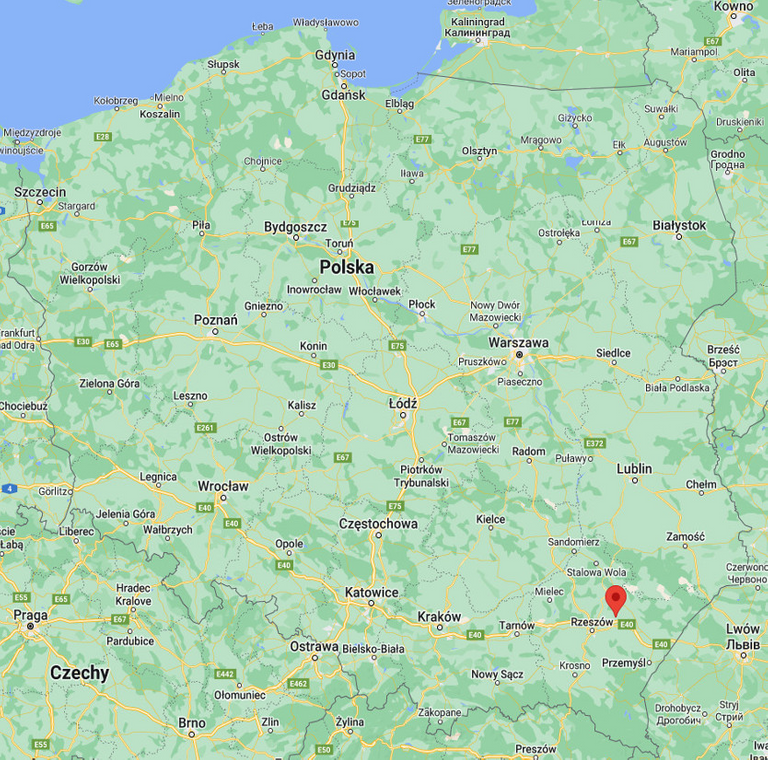
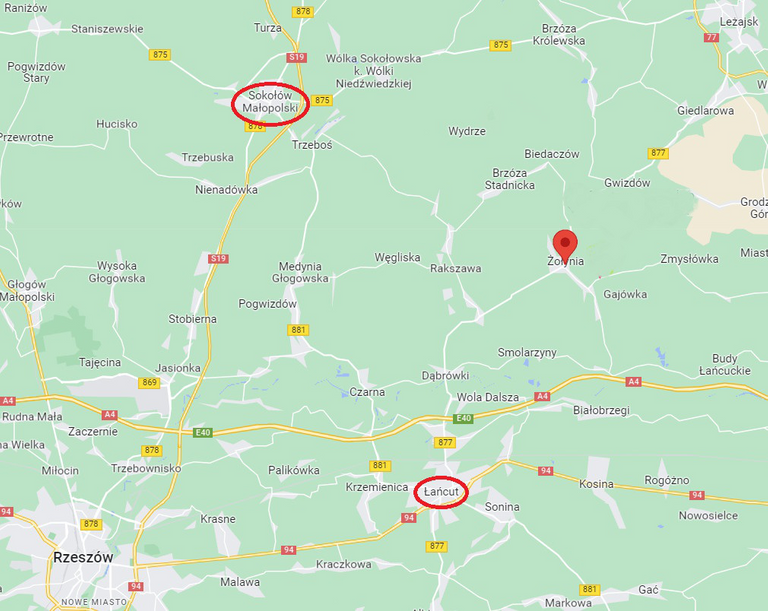
| The person of Stefan Fus in publications, in the light of his work, they present: the Prospectus of the exhibition "Stefan Fus, Art and Painting", TMZS, Sokołów Młp., 1994, as well as, among others: Leszek Walicki [3], Krzysztof Ruszel [5, 6] (former director of the Ethnographic Museum in Rzeszów) Magdalena Kątnik-Kowalska [7, 8]. In the materials belonging to the family, I found a brochure from an exhibition organized by the Municipal Cultural Center in Sokołów Małopolski in 1994. |
| The prospectus outlines the timeframe for further more detailed presentations. When approaching the text critically, it is necessary to fill in some gaps, which - for posterity - require a wider discussion. |
Postać Stefana Fusa w publikacjach, w świetle jego twórczości, przybliżają: Prospekt wystawy ”Stefan Fus, Plastyka i malarstwo” w Sokołowie Młp., 1994, a także m.in.: Leszek Walicki [3], Krzysztof Ruszel [5, 6] (były dyrektor Muzeum Etnograficznego w Rzeszowie), Magdalena Kątnik-Kowalska [7, 8].
W materiałach należących do rodziny znalazłem prospekt z wystawy, która była zorganizowana przez Miejski Dom Kultury w Sokołowie Małopolskim w 1994 r.
Prospekt zakreśla ramy czasowe dalszych dokładniejszych prezentacji. Podchodząc do tekstu krytycznie, należy uzupełnić pewne braki, które - dla potomnych – wymagają szerszego omówienia.
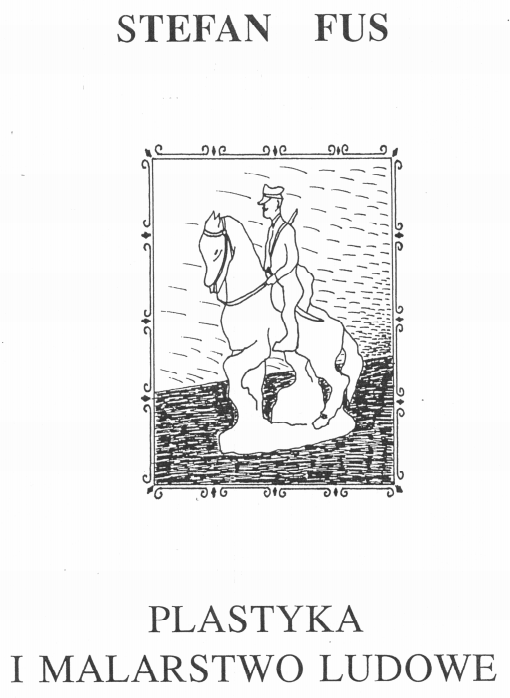
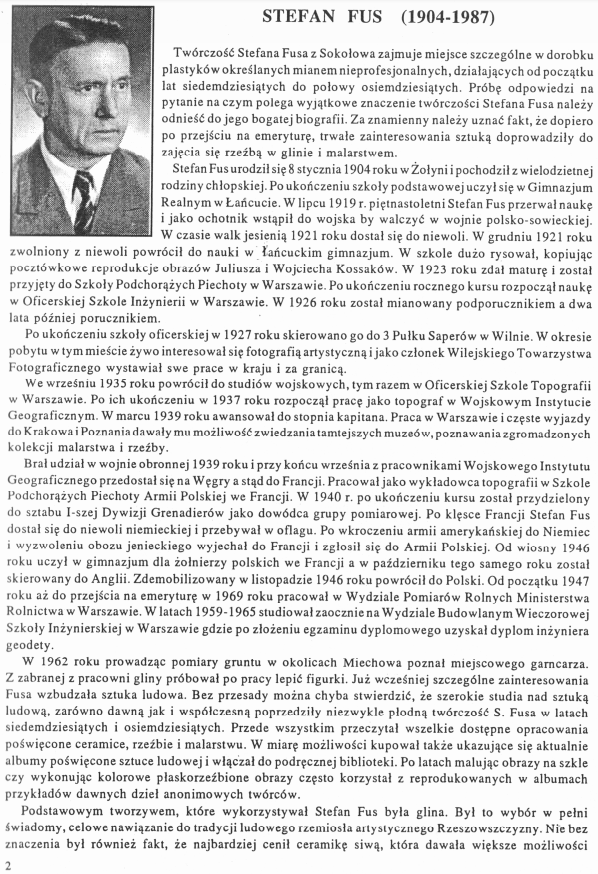
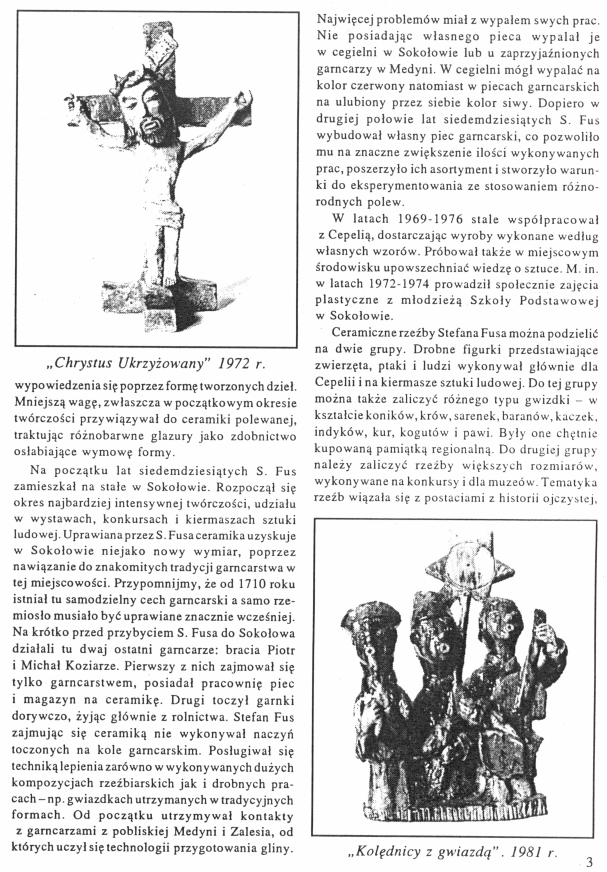
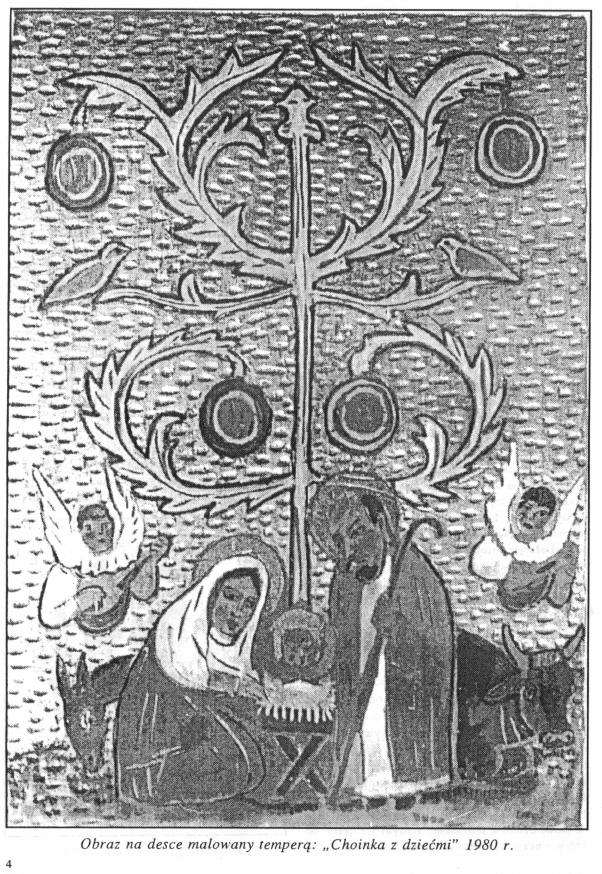
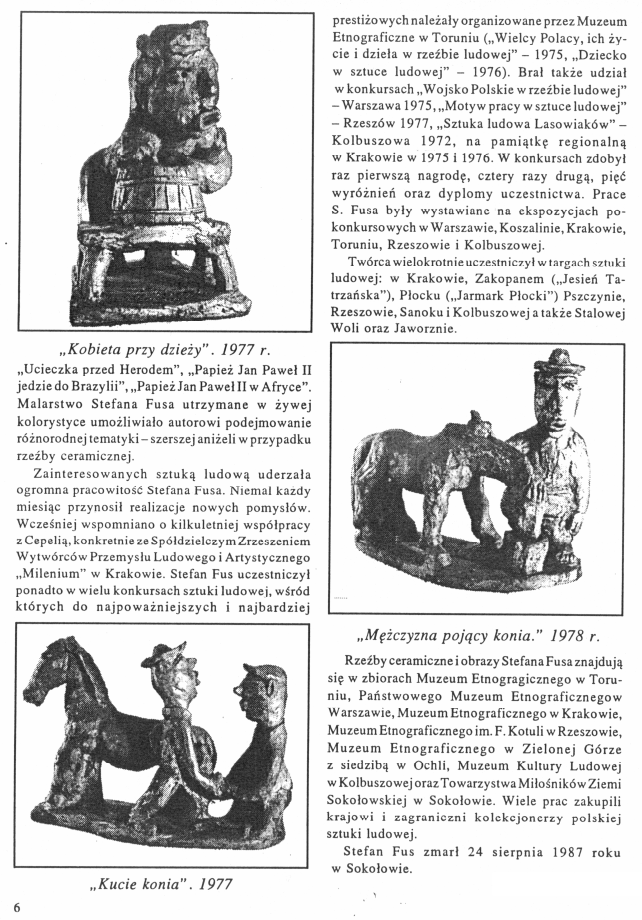
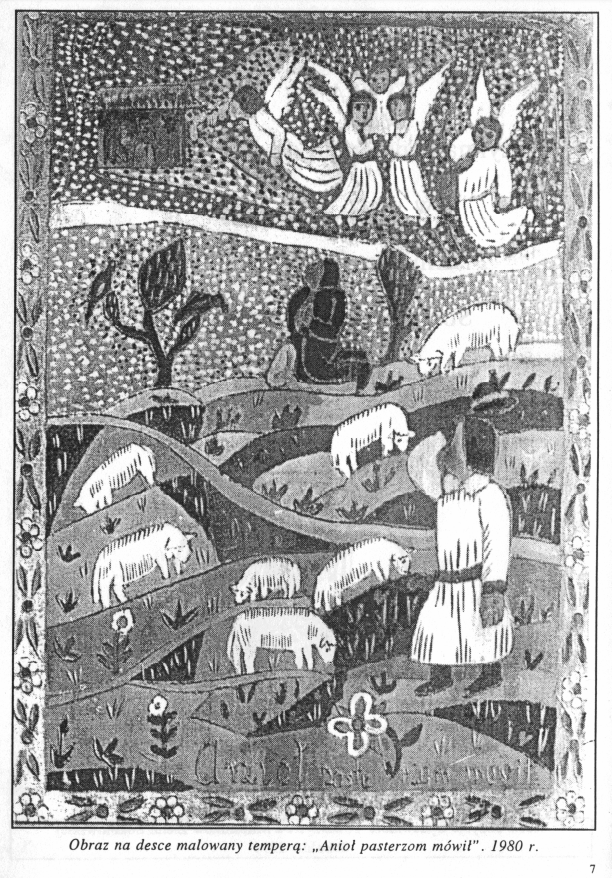
Prospectus of the exhibition of the artistic work of Stefan Fus
at the Municipal Cultural Center in Sokołów Małopolski in 1994
The works of Stefan Fus from Sokołów Małopolski occupy a special place in the achievements of artists known as unprofessional, active from the early seventies to the mid eighties. The attempt to answer the question of what is the unique meaning of Stefan Fus' work should be related to his rich biography. It is significant that it was only after his retirement that his continued interest in art led him to engage in clay sculpture and painting.
Stefan Fus was born on January 8, 1904 in Żołynia and came from a peasant family with many children. After completing primary school, he attended the Real Gymnasium in Łańcut. In July 1919, fifteen-year-old Stefan Fus quit his studies and joined the army as a volunteer to fight in the Polish-Soviet war. During the fights in the fall of 1921 he was captured. In December 1921, released from captivity, he returned to education in the Łańcut gymnasium. At school, he drew a lot, copying postcard reproductions of Juliusz and Wojciech Kossak's paintings. In 1923 he passed his secondary school-leaving examination and was admitted to the Infantry Cadet School in Warsaw. After completing the one-year course, he started studying at the Officers' School of Engineering in Warsaw. In 1926 he was appointed a second lieutenant, and two years later a lieutenant.
After graduating from the officer school in 1927, he was sent to the 3rd Sapper Regiment in Vilnius. During his stay in this city, he was keenly interested in artistic photography and, as a member of the Vilnius Photographic Society, he exhibited his works in Poland and abroad.
In September 1935, he returned to military studies, this time at the Officers' School of Topographers in Warsaw. After graduating in 1937, he started working as a topographer at the Military Geographical Institute. In March 1939, he was promoted to the rank of captain. Work in Warsaw and frequent trips to Cracow and Poznań gave him the opportunity to visit local museums, learn about the collected painting and sculpture collections.
He took action in the defensive war of 1939 (- Poland attacked by Germany and Soviet Russia) and at the end of September, together with the employees of the Military Geographical Institute, made his way to Hungary and from there to France. He worked as a lecturer of topography at the at the Polish Army Infantry School in France.
In 1940, after completing the course, he was assigned to the staff of the 1st Grenadier Division as the commander of the measurement group. After the defeat of France, Stefan Fus was captured by the Germans and stayed in the oflag. After the US army entered Germany and the prisoner-of-war camp was liberated, he left for France and joined the Polish Army. From the spring of 1946, he taught at a gymnasium for Polish soldiers in France, and in October of the same year he was transferred to England. Demobilized in November 1946, he returned to Poland. From the beginning of 1947 until his retirement in 1969, he worked at the Agricultural Measurements Department of the Ministry of Agriculture in Warsaw. In the years 1959-1965 he studied extramural at the Construction Department of the Evening Engineering School in Warsaw, where, after passing the diploma examination, he obtained a surveying engineer diploma.
In 1962, while conducting soil measurements near Miechów, he met a local potter. After work, he tried to stick figures out of the clay he had taken from the studio. Fus had been particularly interested in folk art before. It can probably be said without exaggeration that extensive studies of folk art, both ancient and contemporary, preceded the extremely prolific work of S. Fus in the seventies and eighties. First of all, he read all the available studies on ceramics, sculpture and painting. Whenever possible, he also bought albums devoted to folk art that were published at the moment and included them in the reference library. Years later, when painting pictures on glass or creating colorful, flat-carved pictures, he often used examples of old works by anonymous artists reproduced in albums.
The basic material used by Stefan Fus was clay. It was a fully conscious choice, a deliberate reference to the traditions of the folk art craftsmanship of the Rzeszów region. It was also not without significance that he appreciated gray ceramics the most, which gave greater opportunities to express himself through the form of the works he created. He paid less attention to glazed ceramics, especially in the early period of his creative activity, treating multi-colored glazes as ornaments weakening the meaning of the form.
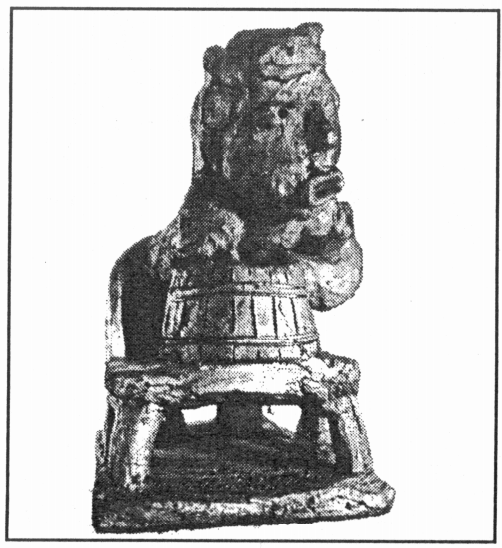
Stefan Fus, ceramic sculpture “A woman mixing her hand in bowl”, 1977
In the early 1980s, S. Fus settled permanently in Sokołów. The period of the most intense creativity began, as well as participation in exhibitions, competitions and folk art fairs. The ceramics cultivated by S. Fus acquires a kind of new dimension in Sokołów, by referring to the excellent traditions of pottery in this town. Let us remind you that from 1710 there was an independent pottery guild here, and the craft itself had to be practiced much earlier. Shortly before the arrival of S. Fus to Sokołów, the last two potters were active here: brothers Piotr and Michał Koziarz. The first of them was only a potter, owned a workshop, a furnace and a ceramics warehouse. The other one turned the pots on a casual basis, living mainly from agriculture. Stefan Fus, dealing with ceramics, did not make vessels turned on a potter's wheel. He used the technique of molding both in large sculptural compositions and in small works - e.g. whistles kept in traditional forms. From the very beginning, he kept in touch with potters from nearby Medynia and Zalesie, from whom he learned the technology of clay preparation. He had the most problems with burning his works. Not having his own furnace, he fired them in a brickyard in Sokołów or at his friends potters from Medynia. In a brickyard, he could fire red, while in pottery ovens, he could fire his favorite gray color. It was only in the second half of the 1970s that S. Fus built his own pottery kiln, which allowed him to significantly increase the amount of work performed, widened their assortment and created conditions for experimenting with the use of various coatings.
In the years 1969-1976 he constantly cooperated with Cepelia, they provide products made according to their own designs. He also tried to disseminate knowledge about art in the local community. Among others in the years 1972-1974 he conducted social art classes with the youth of the Primary School in Sokołów.
The ceramic sculptures by Stefan Fus can be divided into two groups. He made small figurines of animals, birds and people mainly for Cepelia and for a fair of folk art. This group also includes various types of whistles - in the shape of horses, cows, roe deer, rams, ducks, turkeys, chickens, roosters and peacocks. They were eagerly bought regional souvenirs. The second group includes larger sculptures, made for competitions and museums. The subject of the sculptures was related to the characters from the native history, scenes from the life of the former village and the works performed there. Religious themes played an important role, i.e. the figure of the Mother of God, Pieta, scenes from the life of the Holy Family and saints.
In S. Fus's ceramic sculptures, one can find a constantly present and characteristic set of means of expression. The lack of attention to the right proportions and details is striking. He used white tiled clay to make glazed sculptures and clay dug in Sokołów. The colors of S. Fus's sculptures were also an important feature of his work: from intensely red bisque sculptures fired in the local brickyard, through glaze sculptures in various shades of brown, to gray sculptures whose color emphasized the form and contributed to the mood. Visible traces of clay processing are also a specific means of expression, a sign of a creative act. In the case of S. Fus' ceramic sculptures, we are undoubtedly dealing with an attempt to transpose into clay the basic features of an old folk sculpture, i.e. a usually compact body, transforming into parties with a decorative meaning of many realities and striving to express the expression and tension of mental expression. These attempts were made by a conscious artist, familiar with the specificity of folk art, hence in S. Fus's sculptures there is a clear selection of a certain convention of art combined with a spontaneous artistic expression.
Apart from sculpture in clay, S. Fus also performed painting works. He painted mainly on a board covered with a shallow engraving emphasizing the outline of the composition. For some time he also made successful copies of old folk paintings on glass. He did not send his paintings to folk art competitions, but only offered for sale at folk art fairs or museums.
The subject of the paintings was very wide and included mythological, ritual, historical and religious scenes. He also mapped well-known paintings or illustrations from colorful weeklies. For example, in 1973 he painted three pictures depicting Krzysztof Baranowski dressed as a conquistador going on a cruise around the world with his family. In 1980, the collection of the Ethnographic Regional Museum in Rzeszów (next to the F. Kotula Ethnographic Museum in Rzeszów) bought paintings on wood with the following titles by Stefan Fus: "Holy Family", "Dream of the Three Kings", „Nativity play”, "To the nativity scene hey shepherds", "Shepherdess", "Escape of St. Family to Egypt"
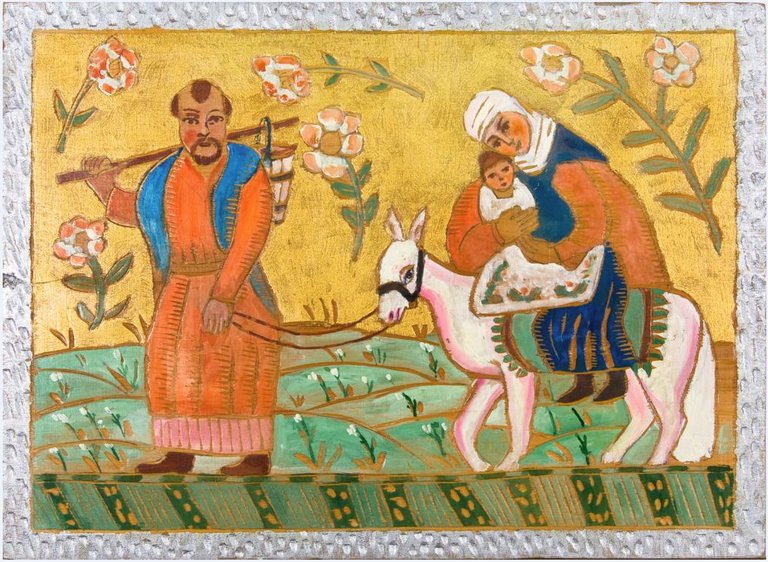
" Byzantine Monarchs", " Massacre of the Innocents", " Gloria with highlander musicians", "Angel told the shepherds", " Came to Bethlehem", " Shepherds and kings with gifts", "Three Kings walking through the deserts", "Nomad Kings", "With a Christmas carol", "Escape from Herod", "Pope John Paul II goes to Brazil", "Pope John Paul II in Africa". Painting by Stefan Fus in vivid colors allowed the author to take up various topics - broader than in the case of ceramic sculpture.
Those interested in folk art were struck by the great diligence of Stefan Fus. Almost every month brought the implementation of new ideas. Earlier, mention was made of several years of cooperation with Cepelia, namely the Cooperative Association of Producers of the Folk and Artistic Industry "Millennium" in Cracow. Stefan Fus also participated in many folk art competitions, among which the most serious and prestigious were those organized by the Ethnographic Museum in Toruń ("Great Poles, their life and works in folk sculpture" - 1975, "Child in folk art" - Warsaw 1975, "Motive of work in folk art" - Rzeszów 1977, "Folk Art Lasowiaks'" - Kolbuszowa 1972, as a regional memorial in Cracow in 1975 and 1976. He won first prize in competitions, four times second, five distinctions and diplomas of participation. The works of S. Fus were displayed at post-competition exhibitions in Warsaw, Koszalin, Cracow, Toruń, Rzeszów and Kolbuszowa.
The creator has repeatedly participated in folk art fairs: in Cracow, Zakopane ("Tatra Autumn"), Płock ("Płock Fair"), Pszczyna, Rzeszów, Sanok and Kolbuszowa, as well as in Stalowa Wola and Jaworzno.
Ceramic sculptures and paintings by Stefan Fus are in the collections of the Ethnographic Museum in Toruń, the State Ethnographic Museum in Warsaw, the Ethnographic Museum in Zielona Góra with its seat in Ochla, the Folk Culture Museum in Kolbuszowa and the Society of the Sokołów Land Lovers in Sokołów. Many works were purchased by Polish and foreign collectors of Polish folk art.
Stefan Fus died on August 24, 1987 in Sokołów Małopolski.
| The work of Stefan Fus should be divided into periods of his life: |
- 1930s: drawing, photography,
- 1950s: photography, watercolor,
- 1960s: watercolor, metalwork, ceramics,
- 1970s and 1980s: ceramics, painting on wood and glass.
Twórczość Stefana Fusa należy podzielić na okresy życia:
- lata 30-te XX w.: rysunek, fotografia,
- lata 50-te XX w.: fotografia, akwarela,
- lata 60-te XX w.: akwarela, metaloplastyka, ceramika,
- lata 70 i 80-te XX w.: ceramika, malarstwo na desce i szkle.
- 1960s: watercolor, metalwork, ceramics,
- 1970s and 1980s: ceramics, painting on wood and glass.
============================= c.d.n. ==== will continue ======================
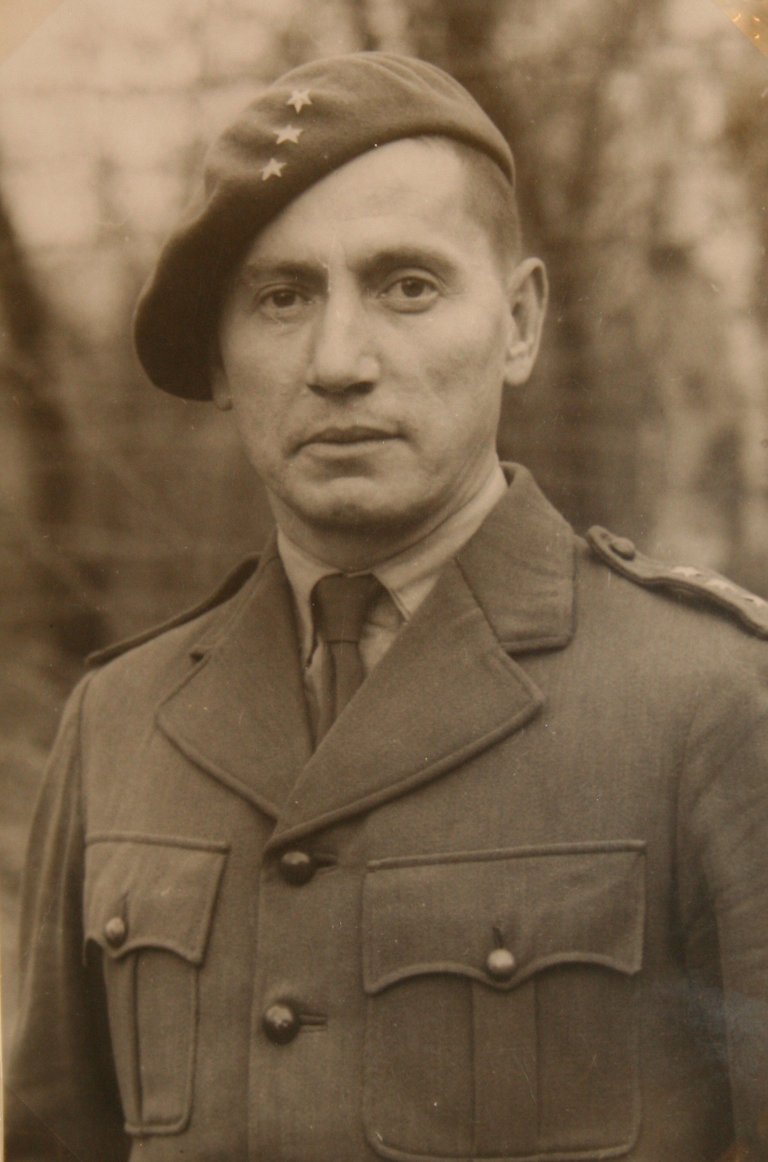
Cpt. Stafan Fus ----------------------- kpt. Stefan Fus ----------------------- 1939 r.